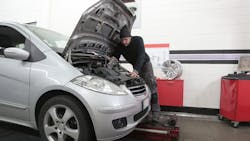The observation "time is money" is as true today as it was way back when Benjamin Franklin suggested as much in his essay "Advice to a Young Tradesman." The value of your shop's time is something to remember when offering a "courtesy inspection" to customers. Today, many shop owners may feel the need to go above and beyond to maintain customer loyalty, but it requires a careful balance to be thorough without doubling the service time.
If customers need to wait too long, they won't see the value, as they often want to get in and out as fast as possible. For those reasons, shops may need to determine how to "right-size" inspections, and determine what is necessary and what's not. In some cases, it could be the customer's decision on what needs to be done, but the basics should be part of standard service. The process can also be an evolution to determine what works best.
That is how Joe Marconi, executive council member for industry consulting firm Elite Worldwide, explains how he handled it as a former shop owner.
"In some cases, the inspection goes too far, not because of the time so much, but because of who is paying for the inspection," Marconi tells National Oil & Lube News. "And many shops don't have a clear method for their technicians."
While a shop owner, Marconi patterned the inspection approach much like when one goes to the doctor. When their appointment begins, patients should expect to receive a "multipoint inspection" that consists of blood pressure, and temperature being taken; followed by a check of their lungs, eyes, and throat. The patients are then asked a few questions about their health conditions and if there are any problems.
"Based on what you are going to the doctor for and the findings from the preliminary check, the doctor will prescribe more lengthy tests," says Marconi.
The same basics could be used when a vehicle rolls into the shop.
Overkill Isn't Necessary
Joe Tilson, owner and operator of Minnesota-based Tilson Auto Repair, currently offers a 64-point inspection on every vehicle that comes through the big doors. That includes a safety check that goes just a bit beyond the basics, and if anything requires a more thorough inspection, the customer is notified.
What is also important to note with Tilson's standard inspection process is that it doesn't keep the customer waiting longer than needed, yet still ensures that any serious problems are encountered before the maintenance begins. The goal is to do an inspection in as little as 10 to 15 minutes and to document everything digitally so that it can be quickly shared with the customer.
"You can spend a lot of time looking for problems, and customers need to understand that they should have to pay for a professional inspection," Tilson tells National Oil & Lube News. "It needs to be said that someone coming in for a basic oil change shouldn't get a $150 inspection for free. We also do the same inspection regardless of the age of the vehicle."
Safe on the Road
Every vehicle that rolls into a shop could receive a basic multipoint inspection to cover the vital safety areas, including lights, tire pressure, wipers, fluid levels, tire condition, steering, and brakes. However, Marconi recommends that the time spent on even this basic level inspection must be calculated in the labor for the service being performed, whether the car is in for an oil change, brake issue, check engine light, or something bigger.
"I am not a fan of giving away any inspection. The only time a comp inspection is performed is if the vehicle is in for a follow-up visit, warranty issue, or doing a courtesy inspection to build value and goodwill," he adds. "Now with that said, the shop must determine if a higher-level inspection is needed, that goes deeper than the basic inspection."
These could include a first-time customer, a vehicle that is coming off a new-car warranty, or even a car that has a lot of miles since the last time it was in for service. In those cases, the vehicle may be due for a more thorough level of inspection. It is then up to the shop operator to determine how much goodwill should be extended for free. In other cases, the added service should be offered to the customer.
"When (this is) determined, the service advisor must be skilled and a process created to sell a higher-level inspection, which checks other items such as the cabin and air filter, fluid condition, health check on the computer system, alignment check, etc.," says Marconi. "This high-level inspection is sometimes sold with a factory service, such as with the 60k or 90k service."
Inspections should always be presented as a "value add," and not become something that can drive away customers by seeming like an unnecessary expense.
"We need to make sure the customer is going to be safe on the road," suggests Tilson. "A lot of operators can scare people away by suggesting they need a deeper inspection. You need to understand a customer's concerns, and what is really important to them."
At Tilson Auto Repair all of the employees can handle the 60-point basic inspections, and pictures are presented to the customer. Further diagnosis can be provided if a problem is encountered based on the customer's discretion. Photos can tell a lot too – and truly a picture is worth a thousand words.
"If you aren't offering a digital inspection, I don't know why not," says Tilson.
Going Deeper
As has been touched up, new customers and vehicles not seen in a while should be offered a more detailed inspection, but for returning customers, a service advisor can use the vehicle history report to see what has been done in the past six months to two years.
"For example, if the cabin and air filter were just replaced four months ago, there is no need to inspect those items again," says Marconi. "However, here's the issue. How do you know that something hasn't happened in the last few days or months? For example, the tires may have been rotated with an alignment at the last service, but the driver hit a pothole, and now the left fron6 tire is wearing funny."
The customer won't be happy if something was missed, but again time is money, and a follow-up inspection after a few months could be wasted time.
To that end, Marconi returns to the way a doctor's office begins every appointment with a basic question such as "Has anything changed since your last visit." A similar question: "Has there been any usual activity or incident with the vehicle that might be an issue," can be asked – saving time while still ensuring that something potentially critical isn't overlooked.
The detail of the inspection can thus be based on what has transpired since the last inspection.
"To summarize, have two levels, a basic inspection, and a more detailed one," says Marconi. "And sell more scheduled interval services. Know when to assign each, and then build the time into the job or service. If you do opt for a no-charge courtesy inspection, give the tech the time for the inspection. And build your overall labor rate and pricing to ensure that the shop is getting paid for all the labor time needed to perform the inspections."
Providing levels of inspections could be something that does help set the shop above the competition.
"Our customers do love the inspections that we offer," says Tilson. "We've heard that we're providing a very thorough inspection. It makes them feel confident that we've done a good job."
About the Author

Peter Suciu
Peter Suciu is Michigan-based writer and NOLN freelance contributor who has contributed to more than four dozen magazines, newspapers and websites. He lives in the land of cars not far from one of Henry Ford's estates.
